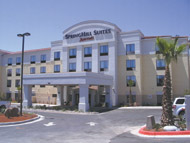| COVER STORY, DECEMBER 2009
ON TOPIC Q&A: HOSPITALITY MARKET
Kevin Hilchey, president and founder of Longview, Texas-based Lodging Host Hotel Corporation (and board member of IAHI, the owners’ association for IHG Hotels), and Mark Crisci, executive vice president of investments and development for San Antonio-based K Partners Hospitality Group, answer our questions about the hospitality market in Texas.
Interviews by Lindsey W. Marcec
TREB: Overall, how has Texas’ hospitality market fared in 2009?
Hilchey: In 2009, the hospitality market in Texas joined the rest of the country. As oil and gas prices fell in the first quarter, layoffs ensued, corporate travel was reduced and personal spending dropped. Texas saw room revenues drop 15.5 percent in the second quarter (according to Source Strategies, Inc.) and REVPAR declined by 19.3 percent, as guest room supply continued to grow at a pace of 4.6 percent. Statewide occupancy dropped to 54.7 percent in the second quarter from 63.1 percent the year prior. In the third quarter the drops seemed to worsen.
Crisci: In early 2009, many of the Texas markets were holding steady. Toward the latter part of ‘09, however, Texas has been more in line with the rest of the nation. We’ve definitely seen a dip in development and overall occupancy.
TREB: Compared to other commercial real estate sectors, how has hospitality performed?
Hilchey: It has faired worse this year than other real estate. The drop in oil and natural gas prices was sudden. Hospitality is considered discretionary spending and was rapidly cut.
Crisci: K Partners works specifically in the hotel sector, so we don’t have first-hand knowledge of how the other sectors are faring.
TREB: Which Texas cities are the most active, in terms of room occupancy?
Hilchey: In the second quarter, declines were broad-based and affected almost all markets. Dallas, Houston and San Antonio all suffered revenue declines of over 18 percent, three points higher than the statewide average. Twenty-six of the 27 metropolitan areas in the state recorded occupancy percentage declines in the second quarter. In new construction, 31,100 net rooms were added to the state supply in the first two quarters of 2009. All metro areas received new supply — not just major cities but small communities as well. This rapid growth, combined with less demand, had its largest impact on some smaller communities where the supply of nice rooms in the market grew more than 100 percent of what had been available in the last 12 months.
 |
K Partners Hospitality Group recently developed a 103-room SpringHill Suites by Marriott in El Paso, Texas.
|
|
Crisci: San Antonio, south Dallas, Fort Worth, El Paso are a few. We are seeing many of these cities in difficult times right now, suffering from the downturn. In general, the tertiary markets are holding up better than many of the major markets.
TREB: Overall, what is happening with hotel construction?
Hilchey: It too is slowing rapidly as lending becomes increasingly challenging. Is there an over-supply? Obviously there is as the state fell below historic industry break-even occupancies.
Crisci: The current pipeline is built out, and, at present, we are definitely seeing an oversupply throughout the main markets in Texas.
TREB: Which hospitality subsector is seeing the most business in 2009?
Hilchey: For the 12 months ending June 2009, all segments were down with the exception of extended stays and limited service, which were basically flat. Luxury? Down the most. Mid-scale? Down about 1 percent in REVPAR. Economy? Flat to up slightly, but not enough to notice.
Crisci: K Partners develops only mid-scale type properties, so that’s really the only sector we can speak to, but in the mid-scale market, we are seeing intense competition.
TREB: How quick do you expect the hospitality market to rebound in Texas?
Hilchey: Many of the brightest say it will be a long recovery; others say it went down fast and will go up just as fast. Hospitality is typically the first to be impacted and the last to pull out. I
think that there is pent-up demand for both leisure and corporate travel. The teleconferencing industry has long predicted the demise of the hospitality business, but I believe that people do business with people. All teleconferencing accomplishes is an increase in the amount of time that we spend in meetings. People will still have to go shake hands with their clients, look them in the eye while negotiating and take them out to lunch.
Crisci: Texas is now in line with much of the economy and needs time to absorb the new product that has been added to the market the last 12 to 24 months. Until we see new jobs created and further indication of an economic rebound, the hospitality market will remain sluggish for the foreseeable future.
TREB: What do you see for the hospitality market in Texas in 2010?
Crisci: We don’t expect a lot of change in the next 12 months. We expect much of our target markets to remain flat with significant competition. Right now, there’s an overabundance of product coupled with a retraction in the economy and it just amplifies the difficult market.
Hilchey: I think that when the numbers come in for the third quarter in Texas they will be worse than the second quarter. It is going to be a long winter in this state. But oil prices are already back up (doubled) from a low of $35 per barrel. That segment is beginning to move and employ people again. A lot of this state is natural gas though, and the price of natural gas is still anemic. The real question is, when will consumers, both corporate and individuals, begin to spend again outside of sustenance levels?
©2009 France Publications, Inc. Duplication
or reproduction of this article not permitted without authorization
from France Publications, Inc. For information on reprints of
this article contact Barbara
Sherer at (630) 554-6054.
|
